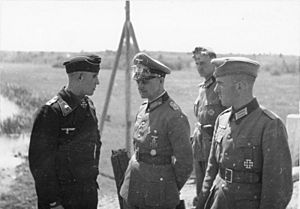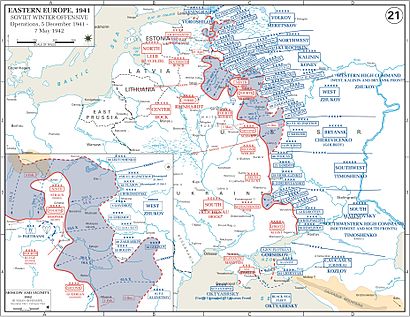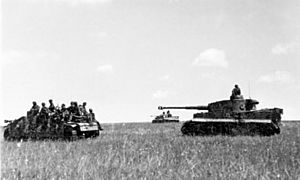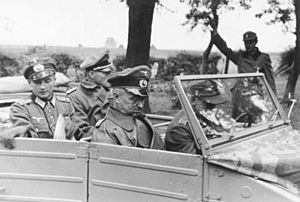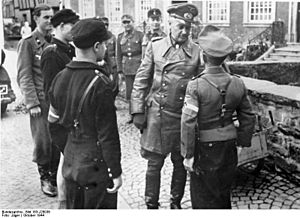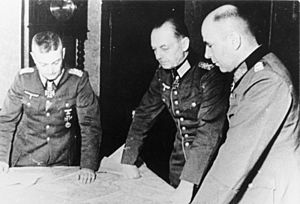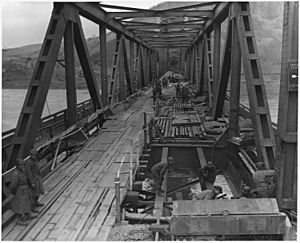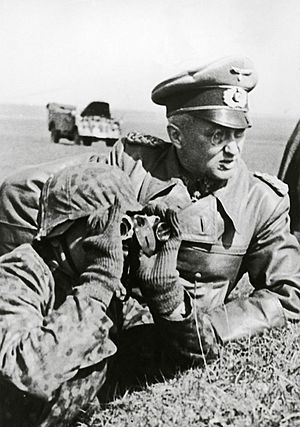Walter Model facts for kids
Quick facts for kids
Walter Model
|
|
|---|---|
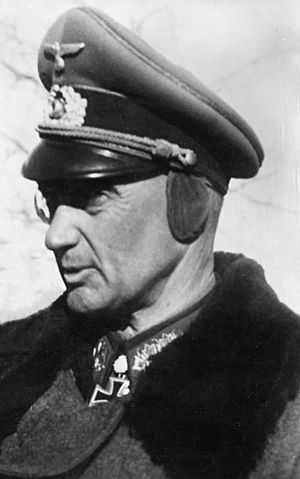
Model c. 1940s
|
|
| Birth name | Otto Moritz Walter Model |
| Born | 24 January 1891 Genthin, German Empire |
| Died | 21 April 1945 (aged 54) near Duisburg, Nazi Germany |
| Buried |
Hürtgenwald (reinterred)
|
| Allegiance | |
| Branch |
|
| Service years | 1910–1945 |
| Rank | Generalfeldmarschall |
| Commands held |
|
| Wars |
|
| Awards | Knight's Cross of the Iron Cross with Oak Leaves, Swords and Diamonds |
Otto Moritz Walter Model (born January 24, 1891 – died April 21, 1945) was a German field marshal during World War II. A field marshal is a very high-ranking military officer. At the start of the war, Model was known for being an aggressive tank commander. Later, he became famous for his skills in defensive warfare. His success leading the Ninth Army in 1941–1942 shaped his future career.
Model first caught the attention of Hitler before World War II. Their relationship grew closer by 1942. Hitler admired Model's tough fighting style and his loyalty. Hitler saw him as one of his best commanders. He often sent Model to fix difficult situations on the Eastern Front. Model commanded important groups like Army Group North and Army Group Centre.
In August 1944, Model was sent to the Western Front. He commanded OB West and Army Group B. His relationship with Hitler became strained near the end of the war. This happened after the German defeat at the Battle of the Bulge.
Contents
Early Life and Military Start
Otto Moritz Walter Model was born in Genthin, Germany. His father, Otto Paul Moritz Model, was a music teacher. Walter came from a middle-class family, not a military one. He burned his personal papers at the end of World War II. Because of this, we don't know much about his early years.
He went to school in Genthin and later in Erfurt and Naumburg. In 1909, he joined the 52nd Infantry Regiment. This was thanks to his uncle, who was a reserve officer. Model became a lieutenant in 1910. He was known for being ambitious and outspoken. These traits stayed with him throughout his career.
World War I Experience
When World War I started in August 1914, Model's regiment was sent to the Western Front. They fought in battles like the Battle of Mons. Model was promoted to first lieutenant in February 1915. He was wounded several times during the war.
His brave actions caught the eye of his commanders. They recommended him for staff training. He completed a short course and worked on the Army General Staff. Model was promoted to captain in March 1918. He fought in the German spring offensive that year. This included battles like Operation Michael.
Between the World Wars
After World War I ended in November 1918, Model's division had to return to Germany. He was praised for keeping his division together during this chaotic time. Model thought about leaving the army. However, his uncle convinced him to stay.
In 1919, he was chosen as one of the 4,000 officers allowed in Germany's smaller post-war army. He avoided politics during this time. But his experiences made him strongly dislike communism.
In 1921, Model married Herta Huyssen in Frankfurt. They had three children: Hella (born 1923), Hansgeorg (born 1927), and Christa (born 1929). He continued to serve in various military roles. He studied tactics and war history. Model was promoted to major in October 1929.
In the 1930s, he worked on developing new weapons. He was a strong supporter of creating armored divisions. He became a major general in March 1938. Model supported the Nazi Party. He was reassigned after a purge of pro-Nazi officers from the Army General Staff.
World War II Campaigns
Invasion of Poland and France
In May 1939, Germany prepared to invade Poland. Model's corps was part of the Tenth Army. World War II began on September 1, 1939. Model's unit saw intense fighting for eleven days.
In October, Model became chief of staff for the Sixteenth Army. This army played a smaller role in the attack on France. Model was promoted to lieutenant general in April 1940. The Sixteenth Army helped encircle 600,000 French troops. Despite the victory, Model was not promoted further at this time.
Invasion of the Soviet Union
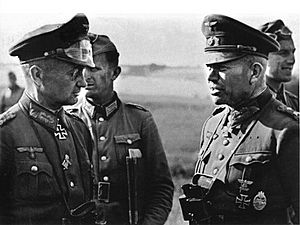
In November 1940, Model was given command of the 3rd Panzer Division. This was a very important role, even though he had no experience with tanks. He trained his soldiers to work together in mixed groups. This was a new idea at the time.
The invasion of the Soviet Union, called Operation Barbarossa, began on June 22, 1941. Model's division advanced quickly. They reached the Dnieper River by July 4. His plan for crossing the river worked very well. He then fought to protect the flank of the German advance.
After the Battle of Smolensk, Model's tank group turned south into Ukraine. Their goal was to trap Soviet forces defending Kiev. Model's 3rd Panzer Division led the attack. By September 14, they had completed the encirclement of Kiev. This led to 665,000 Soviet soldiers being captured.
Fighting Near Moscow
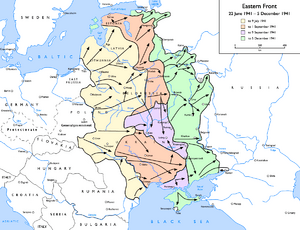
On October 26, 1941, Model took command of the XLI Panzer Corps. He was promoted to general of panzer troops. His corps was involved in Operation Typhoon, the attack on Moscow. Model arrived at his new command in November, during the battle.
The corps was exhausted and far from supplies. The cold weather also made fighting difficult. Despite this, Model pushed his troops forward. By December 5, his units were only 35 kilometers from the Kremlin. But the harsh winter stopped the German advance.
The Soviets then launched a huge counteroffensive. Model's corps faced strong attacks. He managed to pull his troops back without a full retreat. Model noticed that Soviet attacks were most successful against continuous lines. He ordered his men to spread out. He also created small, mobile units to stop breakthroughs. These tactics were successful but costly.
The Rzhev Salient
In January 1942, Model was given command of the Ninth Army. This army was holding the Rzhev salient. Hitler told Model that strong leadership was needed to save the army. Model's firm response impressed Hitler.
When Model took over, the front was in chaos. Soviet forces had broken through. Model immediately counterattacked. He used every available soldier to stop the Soviet advance. He was awarded the Knight's Cross with Oak Leaves and promoted to generaloberst.
Model developed a strong defensive strategy. He used up-to-date intelligence and kept a continuous front line. He also created tactical reserves to stop breakthroughs. Model centralized artillery command. He built multiple lines of defense, even though Hitler had forbidden it. These tactics helped him hold the line.
In July 1942, a new Soviet offensive hit Rzhev. Model returned from leave and quickly organized counterattacks. By September, the Soviet offensive had slowed. In November, the Soviets launched Operation Mars. Model's defenses were tested again. His forces managed to contain and destroy Soviet attacks. Model became known as a "Lion of defense."
In March 1943, the Ninth Army pulled back from the Rzhev salient. This was part of a plan to shorten the front line. Before the retreat, Model ordered a "scorched earth" policy. This meant destroying infrastructure and deporting civilians. The Soviet Union later declared him a war criminal for these actions.
Kursk and Orel Battles
On July 5, 1943, Model led the northern attack on Kursk during Operation Citadel. This plan was controversial among German commanders. Model was doubtful about the attack's chances. He pointed out that Soviet defenses were very strong. He wanted more reinforcements, especially new tanks.
Model's attack failed. His infantry could not break through the strong Soviet defenses. The Germans suffered heavy losses. Model's use of infantry first meant his tank losses were lower than other German commanders.
Model had prepared for a Soviet counterattack. This attack, Operation Kutuzov, began on July 12. Model was given command of the Second Panzer Army in addition to the Ninth Army. The Soviets had a much larger force. Model managed an orderly withdrawal from the salient. He inflicted heavy losses on the Soviets.
As in Rzhev, Model ordered a scorched earth policy during this retreat. He destroyed infrastructure and deported civilians. After losing Orel, Model withdrew to the Dnieper River. He then took three months of leave with his family.
Eastern Front Challenges
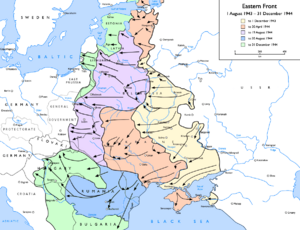
In January 1944, Model was sent to command Army Group North. The situation was very bad. Model created a new policy called "Shield and Sword." This meant giving up ground only temporarily to counterattack. He conducted a fighting withdrawal to the Panther Line. His forces remained mostly intact, but the fighting was fierce. Model was promoted to field marshal on March 30, 1944.
In March 1944, Model took command of Army Group North Ukraine. This group was retreating under heavy Soviet pressure. In June, Model was sent to rescue Army Group Centre, which was being destroyed by Operation Bagration. Model tried to hold Minsk, but it was liberated by Soviet forces.
Model managed to stop the Soviet advance near Warsaw by August 3. He set up a continuous front along the Vistula River.
Western Front Battles
On August 17, 1944, Model was awarded the Diamonds to his Knight's Cross. He was then transferred to the Western Front. He replaced Kluge as commander-in-chief of Army Group B and OB West. The front in Normandy had collapsed. Model convinced Hitler to allow the German Seventh Army to escape the Falaise pocket. This saved many units, though they lost most of their equipment.
Model then set up his headquarters near Arnhem in the Netherlands. He began rebuilding Army Group B. On September 17, his lunch was interrupted by Operation Market Garden. This was an Allied attempt to capture bridges. Model quickly realized the Allied goal. He ordered his II SS Panzer Corps to defend the bridges. This corps, though understrength, was made of experienced soldiers.
Model's defense was very successful. The bridge at Arnhem was held, and the British 1st Airborne Division was destroyed. This stopped the Allies from crossing the Rhine that year.
From September to December, Model fought another Allied push to a standstill. This was in the Battle of Hürtgen Forest and the Battle of Aachen. He used the strong fortifications of the Westwall, also known as the Siegfried Line. The fighting was very costly for the Allies.
Battle of the Bulge
Hitler decided to launch a final offensive in the West. The goal was to retake Antwerp. Model and other commanders believed this goal was impossible. They thought Germany did not have enough resources. Model prepared a less ambitious attack plan. But Hitler rejected it and ordered the larger attack.
Model had three armies for this operation. These armies, with many tanks and planes, were Germany's last major reserve. Despite his doubts, Model worked hard. He told his officers to take what they needed from the Americans.
The attack, known as the Battle of the Bulge, began on December 16, 1944. It had some early success. But it lacked air support and fuel. The attack stalled by December 25 and was abandoned on January 8.
Final Defeat at the Ruhr
The failure of the Battle of the Bulge ended Model's special relationship with Hitler. Hitler took direct control of Model's divisions. He forbade any retreat to the Rhine River.
By mid-March, Model's Army Group B was pushed back across the Rhine into Germany. On April 1, Army Group B was completely surrounded in the Ruhr area. Hitler declared the Ruhr a fortress. He ordered no surrender and no breakout. He also ordered the destruction of Germany's industrial heartland. Model ignored these orders.
On April 15, an American general asked Model to surrender. Model replied that he was bound by his oath to Hitler. He felt he could not formally surrender. Instead, Model ordered his army group to break up. Older and younger soldiers were sent home. The remaining men were allowed to surrender or try to break out on their own. On April 20, the Nazi Propaganda Ministry called Army Group B traitors.
Model's Leadership Style
Walter Model was a very effective commander. However, many people who worked with him found him difficult. He was known for being abusive and micromanaging his officers. He would often change plans without telling anyone.
His troops sometimes found him demanding. But his dislike of bureaucracy made him popular with many soldiers. Model was very good at defensive operations. He could quickly gather reserves from seemingly empty battlefields.
Model was considered an excellent defensive commander. He was also very good at improvising. He was a pioneer in using mixed battle groups. He had a great memory and paid close attention to details. This helped him control his staff officers.
He was known for being a ruthless commander. He was willing to accept heavy losses to stabilize his front. Model often split up units to reinforce critical areas. This allowed him to achieve defensive successes.
Model was very determined and energetic. He refused to accept defeat. He held himself to the same high standards as his men. His visits to the front lines energized his soldiers. His peers respected his ability and strong will. Model's skill at defensive tactics earned him the nickname "Hitler's Fireman." This was because he often saved Germany from difficult military situations.
Relationship with Hitler and Nazism
Many of Model's fellow officers thought he was a Nazi. He often told his troops to have faith in Hitler. He also promoted Nazi ideas. He accepted a Waffen-SS officer as his adjutant.
After the plot to kill Hitler on July 20, 1944, Model was the first senior commander to confirm his loyalty to Hitler. However, he refused to hand over his chief of staff, General Hans Speidel, who was involved in the plot. Model knew about Speidel's political views. Like other commanders, he protected Speidel for as long as he could.
On the Eastern Front, Model did not object to the treatment of civilians by the SS. He oversaw several operations against partisans. These operations were bloody. He also used a "scorched earth" policy during retreats. These actions led the Soviet Union to call him a war criminal.
However, Model refused to send troops to stop the Warsaw uprising. He saw it as a rear-area matter. He said the revolt happened because the Nazis treated the Polish people badly. He thought the army should not be involved.
Some historians believe Model was not necessarily a Nazi. They think he was a strong military leader who saw Hitler as what Germany needed. He was a professional soldier with a strong sense of German nationalism. He was also willing to work with the Nazi regime to achieve his goals.
Model's middle-class background appealed to Hitler. Hitler did not trust the old aristocratic officers. Model's defensive tactics also fit Hitler's desire never to give up ground. Model's stubbornness and direct way of speaking impressed Hitler.
In one famous incident, Model challenged Hitler directly. He asked, "Mein Führer, who commands Ninth Army, you or I?" Hitler was shocked but eventually let Model do as he pleased. This shows that Model had a unique level of trust from Hitler. Hitler called him "my best field marshal." This trust gave Model more freedom than other German generals. He often ignored or changed orders he thought were impossible.
Summary of Career
Dates of Rank
- Lieutenant – August 22, 1910
- First Lieutenant – February 25, 1915
- Captain – March 1918
- Major – October 1929
- Lieutenant Colonel – 1932
- Colonel – October 1, 1934
- Major General – March 1, 1938
- Lieutenant General – April 1, 1940
- General of Panzer Troops – October 26, 1941
- Generaloberst – February 28, 1942
- Field Marshal – March 30, 1944
Service History
- 1909: Officer cadet training
- 1910: 52nd Infantry Regiment
- 1917: Staff assignments
- 1925: Commander, 9th Company, 8th Infantry Regiment
- 1928: Staff officer, 3rd Division
- 1930: Staff officer, Training Section
- 1932: Chief of Staff, Reich Kuratorium for Youth Fitness
- 1933: Battalion commander, 2nd Infantry Regiment
- 1935: Head of Section 8, General Staff
- 1938: Chief of Staff, IV Corps
- 1939: Chief of Staff, Sixteenth Army
- 1940: Commander, 3rd Panzer Division
- 1941: Commander, XLI Panzer Corps
- 1942: Commander, Ninth Army
- January–March 1944: Commander, Army Group North
- March–June 1944: Commander, Army Group North Ukraine
- June–August 1944: Commander, Army Group Centre
- August–September 1944: Commander-in-Chief, OB West
- August 1944 – April 1945: Commander, Army Group B
Awards and Decorations
- Iron Cross of 1914 (2nd Class: 1914, 1st Class: 1915)
- Military Merit Order, 4th class with Swords (Bavaria, 1915)
- Knight's Cross of the Royal House Order of Hohenzollern with Swords (1917)
- Military Merit Cross, 2nd class (Mecklenburg-Schwerin, 1917)
- Military Merit Cross, 3rd class with War Decoration (Austria-Hungary, 1917)
- Ottoman War Medal (1917)
- Wound Badge (1918) in black (1918)
- Spanish Cross (1939)
- Clasp to the Iron Cross (1939) (2nd Class: 1939, 1st Class: 1939)
- Panzer Badge in Silver (1941)
- Wound Badge (1939) in Gold (1942)
- Eastern Front Medal (1942)
- Knight's Cross of the Iron Cross with Oak Leaves, Swords and Diamonds
- Knight's Cross: July 9, 1941
- Oak Leaves: February 17, 1942
- Swords: April 2, 1943
- Diamonds: August 17, 1944
Images for kids
See also
 In Spanish: Walter Model para niños
In Spanish: Walter Model para niños


